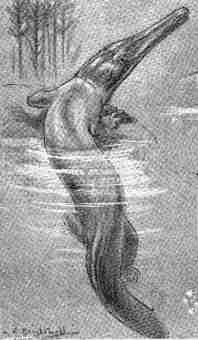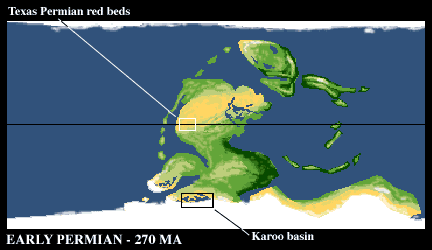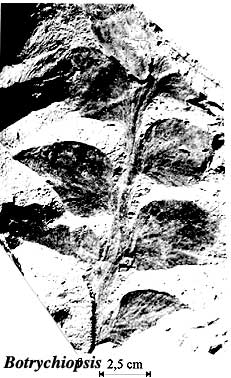
| Cisuralian Epoch | ||
| Paleozoic: Permian Period |
The Asselian Age |
| Gzhelian | Pennsylvanian | Cisuralian | ||
| Sakmarian | Guadalupian | Timescale |

In the geologic timescale, the Asselian is the earliest geochronologic age or lowermost chronostratigraphic stage of the Permian. It is a subdivision of the Cisuralian epoch or series. The Asselian lasted between 299.0 ± 0.8 and 294.6 ± 0.8 million years ago (Ma). It was preceded by the Gzhelian (the latest or uppermost subdivision in the Carboniferous) and followed by the Sakmarian. Yogi111212
 |
A map of the globe during earliest Permian (Asselian-Sakmarian) times.
black: mountains higher than 2000 metres Straddling the equator you can see the C-shaped supercontinent of Pangea, which formed during the late Paleozoic when the globe's major landmasses collided. |
| from Mapping a Planet's Restless Past -The University of Chicago Magazine December 1995 see also the accompanying article by Andrew Campbell |
|

Life in the Asselian times had not changed much from the latest Carboniferous. There were still swampy forests of huge trees, and a fauna dominated mostly by stem tetrapods with only a few medium-sized reptiles
This scene shows some of the inhabitants of a mountain valley community in eastern Euramerica (what is now Germany).
top left to right:
1. Edaphosaurus, a herbivorous pelycosaur;
2. an unnamed seymouriamorph amphibian;
3. an unnamed captorhinid reptile;
4. an unnamed trematopid temnospondyl amphibian;
center
5. Micromelerpeton, a micromelerpetontid temnospondyl;
6. Sclerocephalus, an aquatic actinodontid temnospondyl;
bottom
7. Discosauriscus, an aquatic seymouriamorph;
8. Apateon, an aquatic branchiosaurid temnospondyl.
From A. R. Milner, "Biogeography of Palaeozoic Tetrapods" fig.13.5; in J.A. Long (ed.) Palaeozoic Vertebrate Biostratigraphy and Biogeography, 1993, John Hopkins University Press, Baltimore
| Location | tetrapod zone | approx time | USA | Western Europe | Eastern Europe | |||||
| Age | Utah, Colorado | New Mexico | Texas | Pennsylvania | England | France | Germany | Russian platform | ||
| Asselian | P 2 | 288 | Hotgaita shale |
Moran formation | Washing- ton formation |
|||||
| P 1 | 289 | Abo (Cutler group) |
P u e b l o |
|||||||
| 290 291 |
Kenilworth Sandstone | lower Rottliegendres | lower Rottlie- gendres | "Asselian" | ||||||
* approximate time in MYA (millions of years ago) - nearest million year intervals
* In their chart Anderson & Cruikshank, locate the Abo formation in tetrapod zone 3. However the fact that many of the same species occur in the late Carboniferous El Cobre formation shows that the two strata cannot be that far apart in time
 GeoWhen Database - Asselian: GeoWhen's usual concise and authoritative placement of the age in geochronological context. See also the coverage of the stratotype at Carboniferous - Permian Boundary Stratotype
GeoWhen Database - Asselian: GeoWhen's usual concise and authoritative placement of the age in geochronological context. See also the coverage of the stratotype at Carboniferous - Permian Boundary Stratotype
DinoData: Earth History Maps of Jan Golonka: See Slice 14. These wonderful maps are our primary source for paleogeographical information. Another large-scale map can be found as part of a series reproduced in Mei, S-L, CM Henderson & YG Jin (2004?), Permian conodont provincialism, zonation and global correlation, published on line by the Applied Stratigraphy Research Group of the University of Calgary, Dept Geology & Geophysics.
One of our favorite places on the web is the History of Insects site maintained by the Paleoentomology Institute in Moscow. Among the other treasures on this site are a number of papers -- not always on the subject of insects. For example, this study of Early Permina climate: Chumakov, NM & MA Zharkov (2002), Climate during Permian–Triassic biosphere reorganizations, article 1: Climate of the Early Permian. Strat. Geol. Correl., 10: 586–602.
Upper Palaeozoic floras of SE Asia: pdf Rigby, JF (1998), Upper paleozoic floras of SE Asia, in R Hall & JE Holloway [eds.], Biogeography and Geological Evolution of SE Asia. Backhuys Publ. pp. 73-82. Indispensible data for reconstructing the flora of the period. Not fun reading -- just data. Permian marine biogeography of SE Asia, an article from the same collection by Shi & Archbold, puts the information in paleogeographical context. Prof. Archbold has done a great deal of work in this area. More references can be found at Research Output for Neil Archbold. Another on-line study of the earliest Permian flora can be found at Jasper, A, M Guerra-Sommer, M Cazzulo-Klepzig & R Menegat (2003), The Botrychiopsis genus and its biostratigraphic implications in Southern Paraná Basin. An. Acad. Bras. Ciênc., 75:.513-535 with maps and some nice fossil plant images (see example at right).